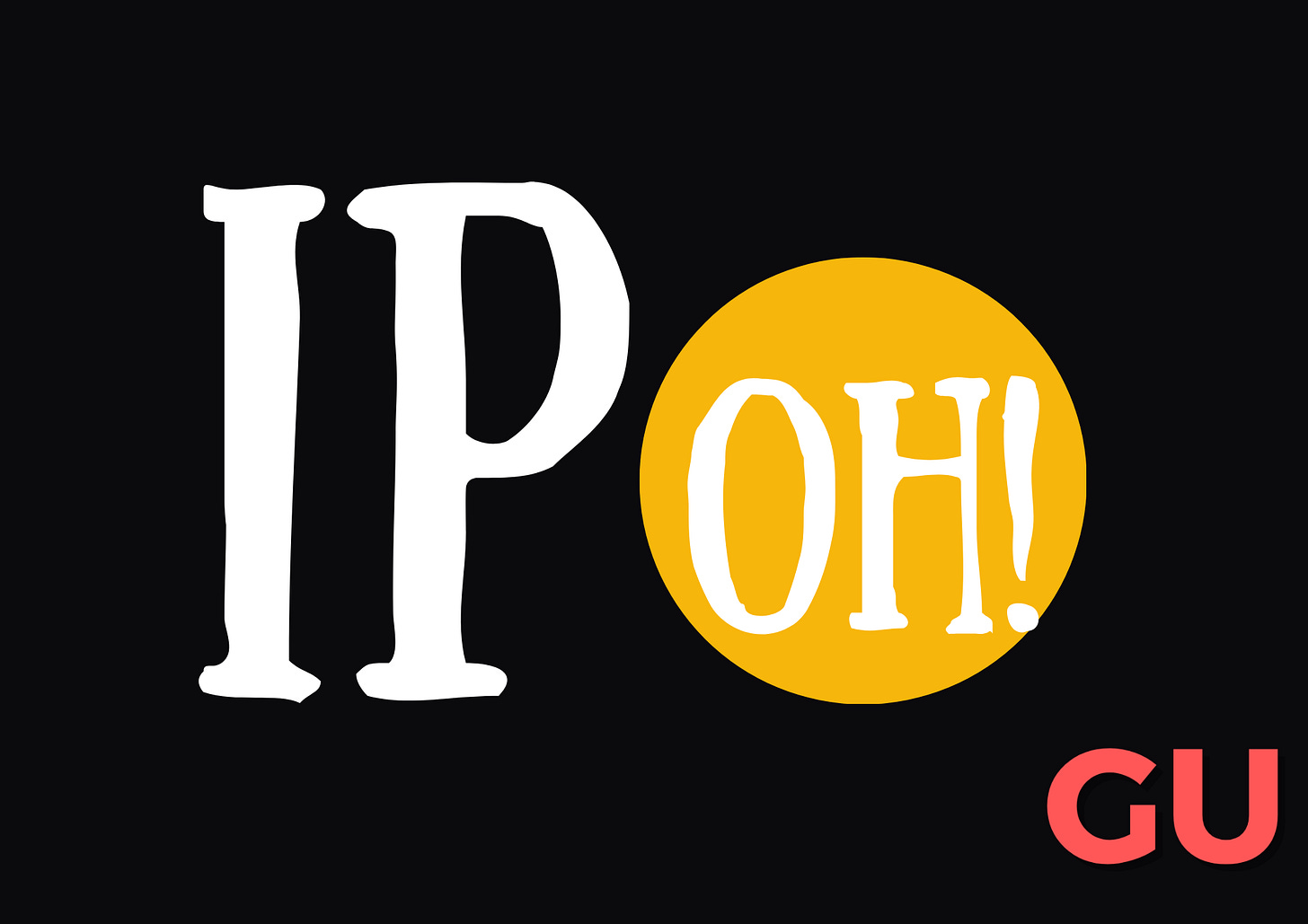Decoding the IPO space
A guide for retail investors to navigate the IPO markets.
Hi!
Reading time: About 9 minutes
Recently a friend of mine asked me what I think about the Mama Earth and Tata Technologies IPO as they subscribed to the IPO. The thinking was behind the growth story in the company. I thought it would be a good idea to write about IPO’s and explain the good and bad.
An IPO is an Initial Public Offering. But Benjamin Graham has a few names which better describe IPO’s:
It’s Probably Overpriced, or
Imaginary Profits Only, or even
Insiders’ Private Opportunity
Let’s try and discuss about IPO’s with all the mental models that we have explored over the span of the last year.
Incentives:
First things first let’s look at the incentives. Why does a company which is doing well decide to get listed in the public markets?
Is it to raise more capital for the business?
Is it for an exit for the existing investors?
Is it to make the company feel more established and make it more reputed?
The answer to this question is tricky. But if I am looking at the incentives of the venture capitalists and angel investors who have invested their money into the business and have already made a 100 times on their investment, I would assume these investors want to ‘cash out’. If not completely at least a portion of their investment they will get a return. So the incentives of the angel investors are to get out of the business.
So you know that the existing shareholders of the company how much ever they deny it want some sort of an exit from the business.
The intermediary, the people who value these businesses, the investment bankers who value the company and then publish reports as to why this company will do well or bad.
What are the incentives for them?
They don’t have any stake in the company. But they do get paid based on commission basis. So even their incentive lies in justifying a high valuation instead of giving a fair one.
Investment bankers work backwards. They first give the valuation then they work on justifying it. It should be the other way around. You have to understand these experts are simply salesmen. They want you to subscribe to this IPO as it fills their pockets. Their incentives make them ‘hype up’ the company, give stories which are very enticing.
Considering the incentives of the already existing investors and investment bankers is not aligned with those of the retail shareholders, it is better to be vary of the information that is coming during an IPO. On top of that it is as history tells us very dangerous to get into a company at a valuation which is very high.
The retail investor sees no benefit from the incentives side.
Buffett:
An IPO is like a negotiated transaction – the seller chooses when to come public – and it’s unlikely to be a time that’s favourable to you. So, by scanning 100 IPOs, you’re way less likely to find anything interesting than scanning an average group of 100 stocks.
Probabilistic thinking:
Now let’s think in terms of probability. Let’s use Bayesian thinking. If IPO investing makes sense of course we have to check the success of all the companies when they were listed and check whether most of them succeeded or most of them failed.
I know the sample size is small and the companies I am showing are not the best examples of IPO’s. But only Zomato is trading at a higher price than new age tech companies which had unreal hype when they were listed.
The data tells me that many IPO’s tend to give mediocre returns in the long term. Companies more often than not do fall under the listing price. Which means opportunities of a valuation being attractive comes in the secondary market as well.
Bayesian thinking tells me for average people IPO’s would fail.
Sanjay Bakshi in an interview with Safal Niveshak:
One of the great lessons from studying history is to do with “base rates”. “Base rate” is a technical term of describing odds in terms of prior probabilities. The base rate of having a drunken-driving accident is higher than those of having accidents in a sober state.
So, what’s the base rate of investing in IPOs? When you buy a stock in an IPO, and if you flip it, you make money if it’s a hot IPO. If it’s not a hot IPO, you lose money. But what’s the base rate – the averaged out experience – the prior probability of the activity of subscribing for IPOs – in the long run?
If you do that calculation, you’ll find that the base rate of IPO investing (in fact, it’s not even investing … it’s speculating) sucks! [T]hat’s the case, not just in India, but in every market, in different time periods.
Charlie Munger said this in Berkshire’s 2004 meeting…
It is entirely possible that you could use our mental models to find good IPOs to buy. There are countless IPOs every year, and I’m sure that there are a few cinches that you could jump on. But the average person is going to get creamed. So if you’re talented, good luck.
As always of course there are IPO’s which succeed. Like Infosys. But most companies don’t. And most people can’t differentiate between the good companies and the bad ones in IPO’s.
Margin of Safety :
Looking at the way that the incentives are lined up and the effect of that being the high valuation that you are paying one thing is certain. The margin of safety for you is very less. At least the margin of safety that comes from valuation is almost non existent. This is due to a lot of factors.
Firstly since the sellers decide when to list they usually only list when there is a bull market and the sentiment towards stocks is high. So naturally there is a lot of money coming in and the sellers use this to their benefit and get their valuation even higher.
Let’s look at the margin of safety from the side of the business. Now as a value investor when you evaluate businesses, of course you need and look for as much information as you can from annual reports, conference calls , etc. Companies which are being listed currently usually do not have a lot of information for you to analyse. So you actually cannot even look for the things that you want. For instance I look for an average return on capital employed of the last 5 years.
So Margin of Safety is also not there when you are entering a business when it is being listed for the first time.
Social Proof and FOMO:
IPO’s usually come out during a bull market. The timing is decided by sellers so more often than not it is when the market sentiment is good. When IPO’s come out everyone wants a piece of it due to the sentiment of the market. So there is a lot of social proof and FOMO that kicks in. People don’t want to miss out on these companies IPO as the brokers and investment bankers push it as a once in a lifetime opportunity to invest in this company early on.
We have the bias of social proof and FOMO which is why we have to be extremely vary when you invest in IPO’s. Ask yourself whether you are investing in IPO’s because of the fundamentals of the company or because everyone has hopped on the IPO train and you don’t want to miss out while others are making money.
Human nature prevents us from ignoring the buzz and hype of the IPO’s that come out. Even though logically speaking there are a lot of things that do not make sense due to our behaviour we ignore these facts and act against what is good for us.
Opportunity Cost :
Let me tell you what investing is to me. Successful investing for me is picking great companies with durable competitive advantages(moats) and this competitive advantage is increasing. At the same time this company has to be available at a valuation which is fair.
To find out if the company has lasting durable competitive advantage you need to know the companies return on capital, financing, cash flows, management quality, and a lot more. To see all of this in my opinion you need a company which has annual reports of at least 5-10 years. Without the data you cannot value companies.
Finding a company which has a moat and is available at a fair valuation is anyways very hard. There are only a few companies which fit the criteria. Then why would you decide to invest in an IPO, instead of finding a company which fits your criteria of successful investing.
Investing in IPO’s is a huge opportunity cost for me. You only find a handful of companies which are great. You need capital and at the same time you need to have a big position in the company. Very hard to invest in IPO’s and then at the same time find these great compounders.
For me IPO’s are mediocre opportunities which are nothing but a distraction from finding the companies one would ideally own.
We have to answer these questions according Jason Zweig,
“One is: what do I know that the other people on the other side of the trade are unlikely to know; and two: why do I think I know more than they do?”
I cannot come up with a strong answer to this question in IPO’s.
So we have seen five mental models.
Incentives: Retail investors see no benefits from the incentive side.
Probabilistic thinking: Base rates tell me that most IPO’s fail.
Margin of Safety: There is no margin of safety in IPO’s
Social Proof and FOMO: It is at an all time high when an IPO is listed.
Opportunity Cost: An IPO is a mediocre opportunity chosen over a better one elsewhere.
Now some might argue saying short term gains for IPO’s are amazing. Almost a guaranteed profit when it lists. Now let’s pause and go back to basics.
What is your job?
Is it speculating what will happen in the short term or is it to invest in businesses and become a business owner?
If you want to speculate, then continue doing so that is a different conversation to have. You can use the mental models to check whether speculation works or not. To me all of this seems insane. You’re basically just hoping.
In the end it is each investor to themselves. Personally I don’t think if you want to be a value investor investing in IPO’s makes sense. If you choose to invest in them all the best to you!
That’s it.






Very well-written and deeply explained. Thanks for changing my thoughts on IPOs and saving me from falling into the IPO trap.